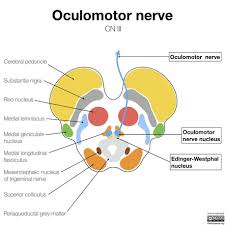 The Edinger–Westphal nucleus is the parasympathetic pre-ganglionic nucleus that innervates the iris sphincter muscle and the ciliary muscle.
The Edinger–Westphal nucleus is the parasympathetic pre-ganglionic nucleus that innervates the iris sphincter muscle and the ciliary muscle.
Also known as the accessory oculomotor nucleus.
Previously, it had been proposed to rename this group of non-preganglionic, neuropeptide-containing neurons to perioculomotor subgriseal neuronal stream, abbreviated pIIISG.[4]
It is the most rostral of the parasympathetic nuclei in the brain stem.
The Edinger–Westphal nucleus supplies preganglionic parasympathetic fibers to the eye, constricting the pupil, accommodating the lens, and convergence of the eyes.
It is implicated in the mirroring of pupil size in sad facial expressions.
When seeing a sad face, individual’s pupils dilate or constrict to mirror the face they saw, which predicted both how sad they perceived the face to be, as well as activity within this region.
